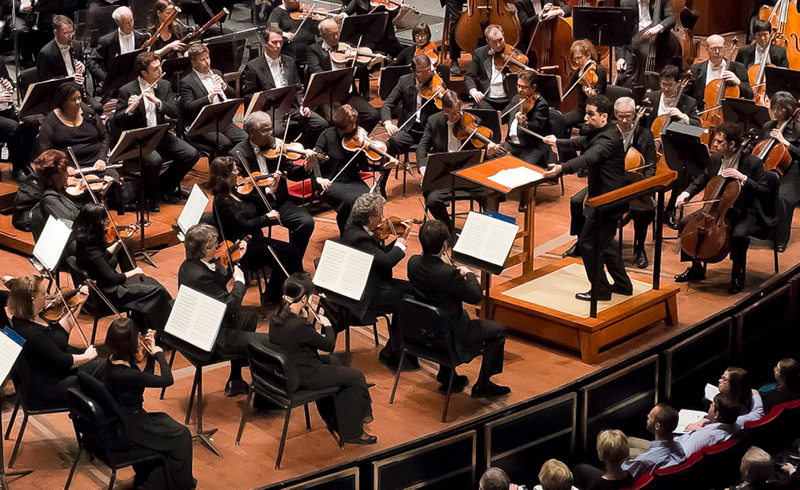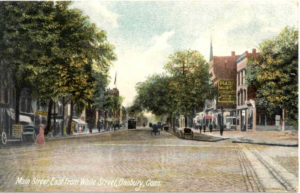
October 16, 2015
Ives’ Symphony No. 2

In 1900, Charles Ives, the dean of American maverick composers, set out to compose his second symphony some ten years after he had finished his first, a work he wrote strictly in a traditional European style as demanded by his professor, Horatio Parker, in order to complete his undergraduate music degree at Yale. This time, Ives wanted to create a symphony in the tradition of European Romanticism but permeated with the character of specifically American melody, binding the two traditions together. Since Beethoven, the composing of symphonies has not been an easy task, and Charles Ives’ Symphony No. 2 is no exception: it took him ten years to produce a final version of his ideas, and four decades to secure a premiere.
It was not until February 22, 1951, that Leonard Bernstein and the New York Philharmonic took on this task at Carnegie Hall in New York City during a concert that was broadcast nationally over the radio. For reasons Ives kept for himself, the composer refused to attend the concert. In his biography of Ives, Jan Swafford relates Ives’ reaction to the radio broadcast of the concert in his book Charles Ives: A Life With Music:
“In legend, [Ives] heard it on the maid’s radio and did a little dance of joy afterward. In reality he was dragged next door to the Ryders’ to hear the broadcast and, unlike similar occasions, sat quietly through the whole thing. It was one of his soft pieces, as he called them; it was also perhaps the warmest audience reception of his whole life. As cheers broke out at the end everybody in the room looked his way. Ives got up, spat in the fireplace, and walked into the kitchen without a word. Nobody could figure out if he was too disgusted or too moved to talk. Likely, it was the latter.”
Every audience that has heard Ives’ music has had to come to grips with his adventurous creativity. As writer Ivan Hewett put it:
“much of the problem in understanding Ives flows from his determination to leap every fence: aesthetic, stylistic, spiritual, and even metaphysical. Whatever the area – simple versus complex, tonality or atonality, comic versus serious, traditional versus revolutionary, abstract versus programmatic, humanistic versus religious, ideal versus concrete – you will tend to find Ives, in his most ambitious work, playing both sides of the game, often on the very same page. He could write fistfuls of clusters resolving in a sentimental parlour song, and mean both. For Ives, paradox led towards truth. All this can make for a crowded and paradoxical music, though Ives’s intentions are lucid and direct.”
In the words of the composer himself, “The fabric of existence weaves itself whole. You cannot set an art off in a corner and hope for it to have vitality, reality and substance.”
This belief is reflected in the unusual way in which he composed his Symphony No. 2. In his effort to combine European and American traditions, Ives liberally quoted musical works from every aspect of life. There seem to be two types of music quoted by Ives: simple, unpretentious bits of musical Americana that would have been familiar to Ives since childhood and quotations from the great European masterworks.
Is there a programmatic reason for these extensive quotations? If there is, it is probably so personal that only Ives knew it. More likely, I think, is a musical reason. As the United States came into its own during the late nineteenth and twentieth centuries, debates raged about what it meant to create “American” works of art. Classical music was especially affected, since its “Europeanness” was considered by many to be one of its defining characteristics. Despite many fine symphonies that had been written by American composers before Ives, this issue was still far from resolved by the time Ives began his Second Symphony.

Charles Ives was interested not only in the sounds that “high” music had to offer, that is, the Masterpieces by the proved Master composers from Europe. He was very interested in the tunes that made up the soundtrack of everyday life itself, music that filled his ears with musical connections, both from the ‘revered’ world of art and from the more general pool of tunes that regular folk would whistle on the way to work or sing at church on Sunday morning.
James Sinclair’s Descriptive Catalog of the Music of Charles Ives and Peter Burkholder’s comprehensive All Made of Tunes both list every known quotation. What I’d like to offer here is an opportunity to listen to them in the context of the symphony itself, movement by movement. As you will hear, Ives does not simply steal famous melodies, but instead uses fragments of them to create his own original music that hints at the traditions of the past.
All examples are linked to The Charles Ives Society, Inc. website and made publicly available here.
Musically based on Ives’s earlier Sonata for Organ and his Down East Overture (both lost), this introductory movement plants the seeds of the symphony’s principal materials:
- the motto phrase of Columbia, the Gem of the Ocean
- the fiddle tune Pig Town Fling:
These two melodies are ingeniously combined so that they sound at the same time. Columbia, the Gem of the Ocean can be heard in the horns, and Pig Town Fling in the violins:
All these ideas will be restated in the same order in the fourth and fifth movements. This movement is connected to the next one attacca, or without pause.
The opening material is virtually a parade of quotes (in order):
- Henry Clay Work’s abolitionist song Wake Nicodemus (“for the great Jubilee”)
- The gospel hymn Bringing In The Sheaves.
- The parody song Where, O Where Are the Pea-green Freshmen? (Here it is sung by the Dartmouth College Glee Club, but aside from the addition of female voices it likely sounded much the same at Yale in Ives’ day.)
After some development of these ideas, Ives has some more to cast and compare: Bringing In The Sheaves once again but in a different key/mode; Where, O Where, also in a different key/mode; Lowell Mason’s Hamburg; and Wake Nicodemus closes with a final celebratory rocket from the “great Jubilee.”
Ives looked to late 19th century Romantic symphonies as his models for the treatment of his themes and transitions: the exposition’s straightforward sequence of tunes resembles Mahler and even more clearly Bruckner, especially the arresting contrasts that articulate its overall design.
III Adagio cantabile
Ives calls the structure of this interlude “à la Brahms,” meaning that the opening material returns at the end virtually unchanged. While the middle section focuses principally on Charles Zeuner’s Missionary Chant (a hymn tune quoted by Ives in many works, partly owing to the resemblance of its opening to the Beethoven’s Fifth Symphony motto), two ideas lead the quoted material here:
- John Sweney’s gospel hymn Beulah Land
- Samuel Ward’s hymn tune Materna
Materna, which Ives uses at the close of the third movement, is a hymn tune written by Samuel A. Ward in 1882. In 1910 it was joined in print to Katherine Lee Bates’s poem America the Beautiful. It is quite possible Ives could have come to associate Materna with America the Beautiful long before 1910. In Ives’ symphony, these melodies are combined into one new, composite melody. Astute listeners may also hear hints of the second movement of Brahms’ Symphony No. 1 blended in as well:
IV Lento (maestoso) and V Allegro molto vivace
During the first stages of the composition, there was only one title for both of these movements. Even though Ives decided later on to transform each section into a movement, they still constitute a single entity. Much in the same way that Brahms opens the last movement of his first symphony, Ives reminds us of melodies that first appeared in earlier movements, such as Massa’s in de Cold Ground; Columbia, the Gem of the Ocean; and Pig Town Fling.
As in the symphony by the German master, Ives’s final Allegro shows his capacity to transform preexisting melodies with predetermined lengths into melodies that are better suited for symphonic writing, where the value of a line is determined by how much you can sustain its development throughout a longer period of time. We can soon discover the presence of Foster’s Camptown Races and Massa’s in de Cold Ground as well as Antioch. Further, fleeting paraphrases of Brahms, Dvořák, and Tchaikovsky—and a longer one from Bach—are worked organically into the flow. Ives’ Second ends with a glorious cacophony: as the trombones blast away on “Columbia, Gem of the Ocean” and the trumpets play “Wake Nicodemus” from the second movement, the violins are furiously trying to keep up with the initial theme of the movement, and the winds hold forth with the hybrid fiddle melody we heard in previous movements:
The last note deserves a special mention in this entry. After an absolutely brilliant display of consonance and evidently successful combination of disparate sources of inspiration, the composer decides to end his symphony with one of the most dissonant chords that had ever been written. Eleven of the twelve possible pitches of the musical scale are used simultaneously. This moment divides his oeuvre in the proverbial before and after. At once it completes his mission of marrying European tradition and new-world inventiveness, but also opens wide the doors for the free exploration and experimentation that he so intensely craved. In a letter to his friend Henry Cowell, Ives describes this last beat of dissonance among an otherwise ubiquitous consonance as “the formula for signifying the very end of the last dance of all: the players play any old note, good and loud, for the last chord.”
Hear Ives’ Symphony No. 2 for yourself this weekend, October 16, 17 & 18, 2015! Get tickets and more info here.






